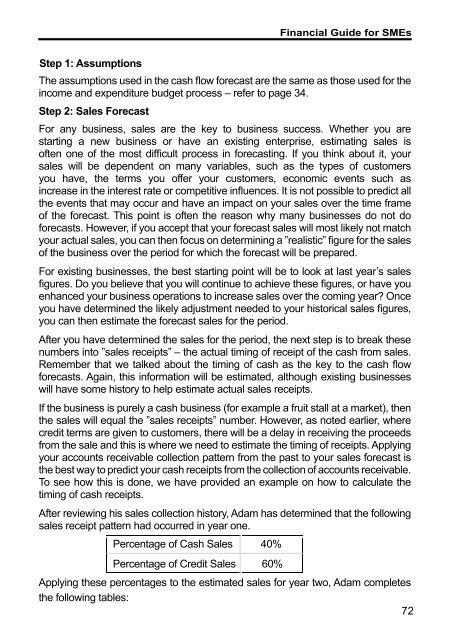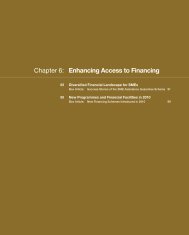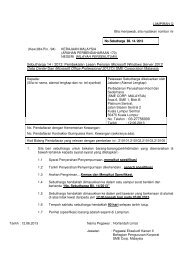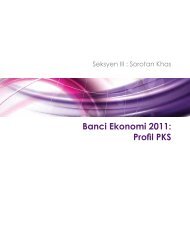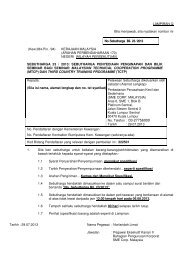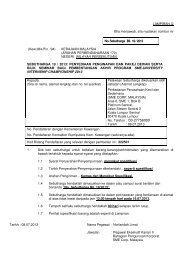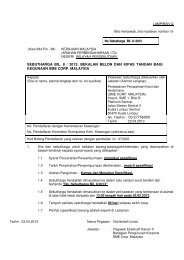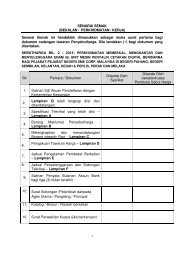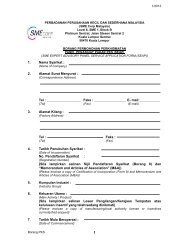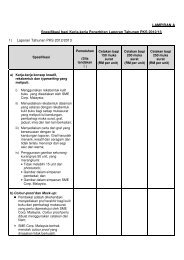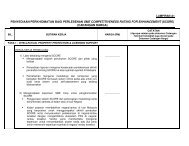Financial Guide for SMEs - SME Corporation Malaysia
Financial Guide for SMEs - SME Corporation Malaysia
Financial Guide for SMEs - SME Corporation Malaysia
You also want an ePaper? Increase the reach of your titles
YUMPU automatically turns print PDFs into web optimized ePapers that Google loves.
<strong>Financial</strong> <strong>Guide</strong> <strong>for</strong> <strong><strong>SME</strong>s</strong>Step 1: AssumptionsThe assumptions used in the cash flow <strong>for</strong>ecast are the same as those used <strong>for</strong> theincome and expenditure budget process – refer to page 34.Step 2: Sales ForecastFor any business, sales are the key to business success. Whether you arestarting a new business or have an existing enterprise, estimating sales isoften one of the most difficult process in <strong>for</strong>ecasting. If you think about it, yoursales will be dependent on many variables, such as the types of customersyou have, the terms you offer your customers, economic events such asincrease in the interest rate or competitive influences. It is not possible to predict allthe events that may occur and have an impact on your sales over the time frameof the <strong>for</strong>ecast. This point is often the reason why many businesses do not do<strong>for</strong>ecasts. However, if you accept that your <strong>for</strong>ecast sales will most likely not matchyour actual sales, you can then focus on determining a ”realistic” figure <strong>for</strong> the salesof the business over the period <strong>for</strong> which the <strong>for</strong>ecast will be prepared.For existing businesses, the best starting point will be to look at last year’s salesfigures. Do you believe that you will continue to achieve these figures, or have youenhanced your business operations to increase sales over the coming year? Onceyou have determined the likely adjustment needed to your historical sales figures,you can then estimate the <strong>for</strong>ecast sales <strong>for</strong> the period.After you have determined the sales <strong>for</strong> the period, the next step is to break thesenumbers into ”sales receipts” – the actual timing of receipt of the cash from sales.Remember that we talked about the timing of cash as the key to the cash flow<strong>for</strong>ecasts. Again, this in<strong>for</strong>mation will be estimated, although existing businesseswill have some history to help estimate actual sales receipts.If the business is purely a cash business (<strong>for</strong> example a fruit stall at a market), thenthe sales will equal the ”sales receipts” number. However, as noted earlier, wherecredit terms are given to customers, there will be a delay in receiving the proceedsfrom the sale and this is where we need to estimate the timing of receipts. Applyingyour accounts receivable collection pattern from the past to your sales <strong>for</strong>ecast isthe best way to predict your cash receipts from the collection of accounts receivable.To see how this is done, we have provided an example on how to calculate thetiming of cash receipts.After reviewing his sales collection history, Adam has determined that the followingsales receipt pattern had occurred in year one.Percentage of Cash Sales 40%Percentage of Credit Sales60%Applying these percentages to the estimated sales <strong>for</strong> year two, Adam completesthe following tables:72Chapter 6 p66-78 Eng.indd 728/15/11 5:02:24 PM


